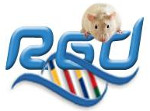Sequences > RGP InformationThis section covers news relating to the rat draft sequence. The goals of this project are outlined in the RFA: Network for Large-Scale Sequencing of the Rat Genome issued by the NHGRI late in 2000. Rat Genome Sequencing Quick Facts:
NHGRI announcement of the publication of the rat draft sequence (Nature April 1, 2004)BETHESDA, Md., Wed., March 31, 2004 - An international research team, supported by the National Institutes of Health (NIH), today announced it has completed a high-quality, draft sequence of the genome of the laboratory rat, and has used that data to explore how the rat's genetic blueprint stacks up against those of mice and humans. In a paper published in the April 1 issue of the journal Nature, the Rat Genome Sequencing Project Consortium describes its efforts to produce and analyze a draft sequence of the Brown Norway strain of the laboratory rat (Rattus norvegicus). The project, led by the Human Genome Sequencing Center at Baylor College of Medicine in Houston, was primarily funded by the National Heart, Lung and Blood Institute (NHLBI), $58.5 million, and the National Human Genome Research Institute (NHGRI), $60 million. "This is an investment that is destined to yield major payoffs in the fight against human disease," said NIH Director Elias A. Zerhouni, M.D. "For nearly 200 years, the laboratory rat has played a valuable role in efforts to understand human biology and to develop new and better drugs. Now, armed with this sequencing data, a new generation of researchers will be able to greatly improve the utility of rat models and thereby improve human health." Areas in which rat models have already helped to advance medical research include: cardiovascular diseases (hypertension); psychiatric disorders (studies of behavioral intervention and addiction); neural regeneration; diabetes; surgery; transplantation; autoimmune disorders (rheumatoid arthritis); cancer; wound and bone healing; and space motion sickness. In drug development, the rat is routinely employed to demonstrate therapeutic efficacy and assess toxicity of drug compounds prior to human clinical trials. The genome sequence will facilitate all of these studies, as well as help researchers better pinpoint the crucial areas of biological difference between rats and humans. Rat Genome Sequencing ConsortiumSequencing of the Rat was accomplished through the efforts of the Rat Genome Sequencing Consortium, which is made up of eight research organizations: Baylor College of Medicine Human Genome Sequencing Center, Houston, TX; Celera Genomics Group of the Applera Corporation, Rockville, MD; The Genome Therapeutics Corporation, Waltham, MA; the British Columbia Cancer Agency, Vancouver, BC; The Institute for Genomic Research, Rockville, MD; the University of Utah, Salt Lake City, UT; Children’s Hospital Oakland Research Institute, Oakland, CA; and the Medical College of Wisconsin, Milwaukee, WI. |
||||||
|
|
 |
 |
 |
 |
RGD is funded by grant HL64541 from the National Heart, Lung, and Blood Institute on behalf of the NIH.














